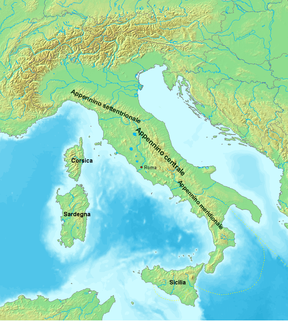
Back Apennyne Afrikaans Apennin ALS Apenins AN أبينيني Arabic Apeninos AST Apennin dağları Azerbaijani Апеннин тауҙары Bashkir Апенінскія горы Byelorussian Апэніны BE-X-OLD Апенински планини Bulgarian
| Apennine Mountains | |
|---|---|
 | |
| Highest point | |
| Peak | Corno Grande (Great Horn) |
| Elevation | 2,912 m (9,554 ft)[1] |
| Listing | List of mountain ranges |
| Coordinates | 42°28′9″N 13°33′56″E / 42.46917°N 13.56556°E |
| Dimensions | |
| Length | 1,200 km (750 mi) northwest to southeast |
| Width | 250 km (160 mi) southwest to northeast |
| Naming | |
| Native name | Monti Appennini (Italian) |
| Geography | |
| Countries |
|
| Geology | |
| Rock age(s) | Mesozoic for formation of rock, Neogene-Quaternary for orogeny |
| Rock type(s) | Apennine fold and thrust belt |
The Apennines[2] or Apennine Mountains (/ˈæpənaɪn/ AP-ə-nyne; Ancient Greek: Ἀπέννινα ὄρη or Ἀπέννινον ὄρος;[3] Latin: Appenninus or Apenninus Mons – a singular with plural meaning;[4] Italian: Appennini [appenˈniːni])[note 1] are a mountain range consisting of parallel smaller chains extending c. 1,200 km (750 mi) the length of peninsular Italy. In the northwest they join the Ligurian Alps at Altare. In the southwest they end at Reggio di Calabria, the coastal city at the tip of the peninsula. Since 2000 the Environment Ministry of Italy, following the recommendations of the Apennines Park of Europe Project, has defined the Apennines System to include the mountains of north Sicily, a total distance of 1,500 kilometres (930 mi).[5] The system forms an arc enclosing the east of the Ligurian and Tyrrhenian seas.
The Apennines conserve some intact ecosystems that have survived human intervention. In these are some of the best-preserved forests and montane grasslands in Europe, now protected by national parks and, within them, a high diversity of flora and fauna. These mountains are one of the last refuges of the big European predators such as the Italian wolf and the Marsican brown bear, now extinct in the rest of Central Europe.
The mountains lend their name to the Apennine peninsula that forms the major part of Italy.[6] They are mostly verdant, although one side of the highest peak, Corno Grande, is partially covered by Calderone glacier, the only glacier in the Apennines.[7] The eastern slopes down to the Adriatic Sea are steep, whilst the western slopes form foothills on which most of the towns of peninsular Italy are located. The mountains tend to be named after the province or provinces in which they are located; for example the Ligurian Apennines are in Liguria.
- ^ "Topographic map of Corno Grande". opentopomap.org. Retrieved 2023-06-11.
- ^ Entry Apennines, in Merriam-Webster Dictionary, on-line on www.merriam-webster.com Archived 2017-05-31 at the Wayback Machine.
- ^ Strabo, Geography, book 5 Archived 2022-10-13 at the Wayback Machine.
- ^ Cite error: The named reference
Lewis_1879was invoked but never defined (see the help page). - ^ Cite error: The named reference
Gambino-and-Romano_2000-2001was invoked but never defined (see the help page). - ^ Lake 1911, p. 161.
- ^ Pedrotti & Gafta 2003, p. 75
Cite error: There are <ref group=note> tags on this page, but the references will not show without a {{reflist|group=note}} template (see the help page).
